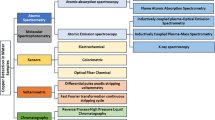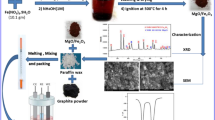Abstract
The behavior, effects, and toxicity of an element often depend largely on its speciation. In this study, the speciation of copper (Cu) in seawater was investigated via the fixed-point determination of electroactive Cu, acid-dissolved Cu, inert Cu, and total dissolved Cu using a voltammetric method with an electrochemical sensor. This method was found to be simple and effective for speciation analysis as no complicated pretreatment or separation steps were required, permitting its use for the direct determination of Cu speciation in real water samples with confirmed accuracy. Moreover, following simple electrolytic cleaning, the sensor exhibited good measurement stability and reproducibility when it was reused. Fixed-point determinations of electroactive Cu, acid-dissolved Cu, inert Cu, and total dissolved Cu in local seawater were carried out for 15 days. The total dissolved Cu concentration ranged from 45.03 to 122.85 nM, and its average concentration was 66.05 nM. The speciation of Cu was influenced by external environmental changes to some extent but was observed to remain relatively constant. The correlations between the concentrations of different Cu species and environmental parameters are discussed here in detail.






Similar content being viewed by others
References
Abdelraheem WHM, Zanaty RK, Ismail NM (2017) Electrochemical determination of Cu2+ complexation in the extract of E. crassipes by anodic stripping voltammetry. Arab J Chem 10:S1105–S1110
Adnívia SCM, Corinne P, André HR, José PP (2016) Towards field trace metal speciation using electroanalytical techniques and tangential ultrafiltration. Talanta 152:112–118
Annibaldi A, Illuminati S, Truzzi C, Scarponi G (2011) SWASV speciation of Cd, Pb and Cu for the determination of seawater contamination in the area of the Nicole shipwreck (Ancona coast, Central Adriatic Sea). Mar Pollut Bull 62:2813–2821
Batley GE, Florence TM (1971) A novel scheme for the classification of heavy metal species in natural waters. Anal Lett 9:379–388
Brown PL, Markich SJ (2000) Evaluation of the free ion activity model of metal–organism interaction: extension of the conceptual model. Aquat Toxicol 51:177–194
Byrne RH, Miller WL (1985) Copper(II) carbonate complexation in seawater. Geochim Cosmochim Acta 49(8):1837–1844
Capodaglio G, Toscano G, Scarponi G, Cescon P (1994) Copper complexation in the surface seawater of Terra Nova Bay (Antarctica). Int J Environ Anal Chem 55:129–148
Capodaglio G, Turetta C, Toscano G, Gambaro A, Scarponi G, Cescon P (1998) Cadmium, lead and copper complexation in Antarctic coastal seawater. Evolution during the austral summer. Int J Environ Anal Chem 71:195–226
de Polo A, Scrimshaw MD (2012) Challenges for the development of a biotic ligand model predicting copper toxicity in estuaries and seas. Toxicol Chem 31(2):230–238
Florence TM (1986) Electrochemical approaches to trace element speciation in waters: a review. Analyst 111:489–505
Gledhill M, van den Berg CMG (1995) Measurement of the redox speciation of iron in seawater by catalytic cathodic stripping voltammetry. Mar Chem 50:51–61
Grosell M, Wood CM (2002) Copper uptake across rainbow trout gills: mechanism of apical entry. J Exp Biol 205(8):1179–1188
Guo X, Ma Y, Wang X, Chen S (2010) Re-evaluating the effects of organic ligands on copper toxicity to barley root elongation in culture solution. Chem Speciat Bioavailab 22(1):51–59
Hirose K (1994) Conditional stability constants of metal complexes of organic ligands in sea water: past and present, and a simple coordination chemistry model. Anal Chim Acta 284:621–634
Hirose K (2006) Chemical speciation of trace metals in seawater: a review. Anal Sci 22:1055–1063
Huang S, Wang Z (2003) Application of anodic stripping voltammetry to predict the bioavailable/toxic concentration of Cu in natural water. Appl Geochem 18:1215–1223
Jacquot JE, Horak REA, Amin SA, Devol AH, Ingalls AE, Armbrust EV, Stahl DA, Moffett JW (2014) Assessment of the potential for copper limitation of ammonia oxidation by Archaea in a dynamic estuary. Mar Chem 162(20):37–49
Kot A, Namiesnik J (2000) The role of speciation in analytical chemistry. Trend Anal Chem 19:69–79
Laglera LM, Santos-Echeandía J, Caprara S, Monticelli D (2013) Quantification of iron in seawater at the low picomolar range based on optimization of bromate/ammonia/dihydroxynaphtalene system by catalytic adsorptive cathodic stripping voltammetry. Anal Chem 85:2486–2492
Mart L (1979) Prevention of contamination and other accuracy risks in voltammetric trace metal analysis of natural waters. Pt I: Preparatory steps, filtration and storage of water samples. Fresenius Z Anal Chem 296:350–357
Mart L, Nürnberg HW, Valenta P (1980) Prevention of contamination and other accuracy risks in voltammetric trace metal analysis of natural waters. Pt III: Voltammetric ultratrace analysis with a multicell system designed for clean bench working. Fresenius Z Anal Chem 300:350–362
Palma O, Kristijan V, Marta P, Irena C, Ivan Š, Tatiana M (2016) Voltammetry as a tool for rough and rapid characterization of dissolved organic matter in the drainage water of hydroameliorated agricultural areas in Croatia. J Solid State Electron 20:3097–3105
Patterson C, Settle D, Glover B (1976) Analysis of lead in polluted coastal seawater. Mar Chem 4:305–319
Plavšić M (2003) Electroanalytical techniques applied for studying the interaction of organic matter and particles with metal ions in natural waters. Anal Lett 36:143–157
Plavšić M, Lee C, Ćosović B (2006) Copper complexing properties of melanoidins and marine humic material. Sci Total Environ 366:310–319
Plavšić M, Orlović-Leko P, Kozarac Z, Bura-Nakić E, Strmečki S, Ćosović B (2008) Complexation of copper ions in atmospheric precipitation in Croatia. Atmos Res 87:80–87
Santore RC, Di Toro DM, Paquin PR, Allen HE, Metey JS (2012) Biotic ligand model of the acute toxicity of metals. 2. Application to acute copper toxicity in freshwater fish and Daphnia. Environ Toxicol Chem 20(10):2397–2402
Schroeder H, Fabricius AL, Ecker D, Ternes TA, Duester L (2017) Metal(loid) speciation and size fractionation in sediment pore water depth profiles examined with a new meso profiling system. Chemosphere 179:185–193
Tait TN, Rabson LM, Diamond RL, Copper CA, McGeer JC, Smith DS (2016) Determination of cupric ion concentrations in marine waters: an improved procedure and comparison with other speciation methods. Environ Chem 13:140–148
van den Berg CMG (1982) Determination of copper complexation with natural organic ligands in seawater by equilibration with manganese dioxide. I: Theory. Mar Chem 11:307–322
Wang Z, Yao L, Liu G, Liu W (2014) Heavy metals in water, sediments and submerged macrophytes in ponds around the Dianchi Lake, China. Ecotoxicol Environ Saf 107:200–206
Whitby H, van den Berg CMG (2015) Evidence for copper-binding humic substances in seawater. Mar Chem 173:282–290
Acknowledgements
This research was supported by the Youth Innovation Promotion Association (2011170) and the Equipment Development Project (YZ201558) of the Chinese Academy of Sciences. We thank MogoEdit for its linguistic assistance during the preparation of this manuscript.
Author information
Authors and Affiliations
Corresponding author
Electronic supplementary material
Below is the link to the electronic supplementary material.
Rights and permissions
About this article
Cite this article
Hu, X., Pan, D., Han, H. et al. Anodic stripping voltammetric analysis of different species of copper in seawater using an electrochemical sensor. J Oceanogr 75, 149–156 (2019). https://doi.org/10.1007/s10872-018-0491-z
Received:
Revised:
Accepted:
Published:
Issue Date:
DOI: https://doi.org/10.1007/s10872-018-0491-z




